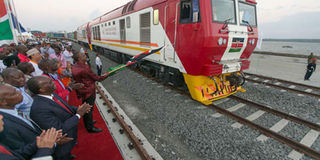SGR launch marks second phase of Kenya’s history

President Uhuru Kenyatta starts the cargo freight service of the standard gauge railway in Port Reitz, Mombasa in May 2017. PHOTO | SAMUEL MIRING'U | PSCU
What you need to know:
- Despite criticism from the Opposition, President Uhuru Kenyatta said, the launch of the standard gauge railway would “reshape the story of Kenya for the next 100 years”.
- The plan to construct the Kenya-Uganda railway in July 1895 had attracted criticism.
The launch of the standard gauge railway 18 months ahead of schedule was due largely to the personal zeal and commitment of President Uhuru Kenyatta. Despite criticism from the Opposition, he said, the launch of Madaraka Express would “reshape the story of Kenya for the next 100 years”. It marks the second and a historic phase.
The plan to construct the Kenya-Uganda railway in July 1895 had also attracted criticism. It had cost the British exchequer £5.5 million. The Liberals, Radicals and Irish nationalists described it as “gigantic folly”, and Elspeth Huxley wrote, “Never before or since, has such an impracticable, extravagant and uneconomical railway been planned”. However, the British under Secretary of State and Foreign Affairs explained the profitability and benefits of constructing the railway. Prime Minister Lord Salisbury went further and assured Parliament that the railway would deliver a fatal blow to the slave trade that Britain was committed to end, dry up supplies to caravans and the trade that supported them and thereby boost British trade.
INDIAN ENTREPRENEUR
A contract to supply material, labour and personnel was given to a Karachi-based Indian entrepreneur, A.M. Jeevanjee, who recruited workers from India with three-year contracts at the end of which they could stay on in Kenya for a further period of employment or return home.
Kenya was then a country of dense forest and mile upon mile of bush. No survey had been carried out when the decision was made to build the railway. There were no maps, only sketch plans prepared by travellers from notes or compass bearings taken along the line. Distances were estimated according to time taken to walk from one camp to another. Every camp position was checked by latitude and longitude using chronometers. The accuracy of each watch was checked by occultations of the stars, the moon or of Jupiters satellites.
The Foreign Office seconded British engineers from India who were “old hands familiar with the Indian ways and fluent in Hindustani” to oversee the construction.
The first group of Indian workers to arrive consisted of 350 men who came in a dhow from Karachi in 1895. They travelled in dhows and on steam ships. Of 31,983 workers who came, 2,493 died in the construction – four workers for each mile of line laid; more than 38 dying every month during the six years.
The great majority of Railway employees returned to India on the completion of the project. Some 6,000 stayed on, some as employees of the railway, others joining the rapidly expanding administration, and many as independent artisans, entrepreneurs and professionals.

The "Lunatic Express" near the standard gauge railway's terminus in Mtito Andei, Makueni. PHOTO | JEFF ANGOTE | NATION MEDIA GROUP
The first rail was laid in Mombasa on May 30, 1896 in the presence of the East Indies squadron that sailed into Mombasa with the band playing the “Boulanger” march.
It reached Tsavo two years later. But progress was hampered by two lions, described as the Man Eaters of Tsavo. They are estimated to have killed 85 African workers, and 25 Indians but the exact number is not known. They also killed a British superintendent Charles Ryall as he stood watch. An Indian worker in a hospital tent was devoured a few feet away. All that was found was his skull and several fingers.
Lt-Col John Patterson, an engineer, was commissioned to oversee the construction of a bridge over the Tsavo River. He had for many years stalked tigers in India. He demanded unquestioning obedience from the workers for whom he wrote the lions “had conceived a most unfortunate taste” for the Indian vegetarian and organic flesh.
LIONS KILLED
Patterson separately killed the two lions in December 1898, and narrowly escaped death. Both lions were over nine feet long from nose to the tip of the tail and had to be carried by eight men to the camp. They are displayed in Chicago’s Field Museum.
The 581 miles of difficult terrain from Mombasa to Port Florence (Kisumu) took five years to build. No machinery was available then and they built by hand the Salisbury Bridge – more than 1,200 feet long, joining Mombasa Island to the mainland.
The Times in an editorial wrote: “The Railway is altogether 572 miles long, but its mere length does not convey the difficulties which had to be overcome in carrying the steel up from the shores of the Indian Ocean. The cost has been proportionately great, yet there are few people in this country who would now question the great utility of this expenditure.”
This article includes excerpts from ‘Indian Dukawallas: Their contribution to the Political and Economic Development of Kenya’ by Sharad Rao.




